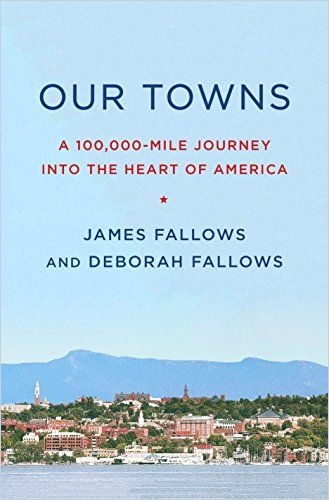Don’t fly over America’s small towns. Instead, fly in for a portrait of the current and likely future state of US cities.

Flying In
Journalist James Fallows and linguistics expert Deborah Fallows, his wife and co-author, flew 100,000 miles in the course of four years, visiting 31 cities several times each to report on their economic and civic health and future prospects. The authors find that cities that differ in history, geography and opportunity are similar in their aspirations and economic development strategies. Like the best travelogues, this makes you want to visit places you never dreamed of exploring.
The authors’ overview of civic and economic determination will intrigue investors, entrepreneurs and armchair travelers, as well as anyone – especially in the tech sector – interested in the United States’ urban future.
From 2,500 feet above the ground…you can see far enough in all directions to notice how cities interleave with suburbs, or how the course of a river, a ridge or a tree line shapes the farmland and settlements.James and Deborah Fallows
Reviewers greeted the book warmly. Kirkus Reviews called it, “An illuminating trip through parts of the country generally missed by the media spotlight… Writing with lively curiosity and open minds, the couple have created textured portraits of 29 American cities…a well-reported, optimistic portrait of America’s future.” Joe Scarborough of MSNBC’s Morning Joe added, “This country is more united than divided…and this book will prove it.”
Good News
The Fallowses offer good news about small-town America, particularly focusing on how municipalities are finding that making the most of their local attributes is the surest path to revitalization. This includes the comfortable size of Sioux Falls, South Dakota; the beauty of Bend, Oregon; the waterfalls of Greenville, South Carolina; and the lakeshore of Burlington, Vermont.
These revitalizing cities are using their existing resources to spur economic growth. For example, Eastport, Maine has the deepest harbor on the Eastern seaboard. Melting arctic ice means it may one day offer the quickest sea route to Asia. Bay of Fundy tidal currents made Eastport ideal for the Ocean Renewable Power Company to test its generation of hydrokinetic electricity, which supplies Maine’s power grid. Natives of Fresno, California are coming home after college to boost local education and attract development. Given the area’s farmlands, they’re focusing on developing agricultural tech. The residents’ refrain is “Fresno? It’s Fres-yes!”
Northern cities had to rearrange themselves for an economy of smaller, faster-changing, higher-value manufacturing sites; more offices and co-working spaces; less automobile-centric development and more walkable streets.James and Deborah Fallows
Allentown, Pennsylvania’s industrial-era manufacturing base has become an asset that is enticing smaller start-ups. The Fallowses cite an old Mack Truck factory which now houses a “makerspace” where members learn to use expensive tools. In other trends the Fallowses identify, affordable housing, easy commutes and lower operating costs are also luring new businesses to Allentown.
The Fallowses also provide historical context by drawing a line from the public investments of a previous age to today’s new opportunities and progress. For example, in the 1990s, Citibank was drawn to the World War II-era military infrastructure of Sioux Falls, which offers lower operating costs than other, more dense areas. Residents love its “big small town” feel.
Local Teamwork
The authors find that cities with political differences – ultraconservative Greenville, ultraliberal Burlington – still share some commonalities. Both of these towns enjoy bustling, waterfront downtown areas, strong mayors, minor league baseball teams and decent regional airports. The cities and their states work jointly to bring in big companies, and Greenville is also nurturing small homegrown businesses.
In Dodge City, Kansas, voting against tax increases is axiomatic – except, as the authors report, at the local level. Residents rallied behind the “Why Not Dodge?” sales tax to raise dedicated funding for improving the civic infrastructure, including soccer and sports fields, a civic center and a public water park. The book’s heroes are the local boosters who invest in their hometowns. For instance, Eastport’s Women of the Commons, a group of six friends, rehabbed an abandoned building into an art gallery and apartments for tourists or visiting artists and writers.
Although the national political scene is polarized, the Fallowses learned that productive local outcomes usually come from a thoughtful community process free of such contention – not that every decision works, but, they report, a cooperative process is the most promising route. Since political paralysis threatens at the national level, the Fallowses find, cities and regions must adapt and develop their own resources and resilience. And that’s what these towns are doing.
Public-Private Partnerships
James and Deborah Fallows pay particular attention to public-private partnerships. For instance, with the approval of the state legislature, Allentown’s “Neighborhood Improvement Zone” offers tax breaks for downtown investments, which include a concert and sports arena that spawned smaller-scale investment.
Libraries…have become the heart and soul of America.James and Deborah Fallows
The Fallowses join other authors in reporting a revitalization of America’s libraries, which now offer yoga classes, book readings, story hours, after-school homework help and citizenship classes. Librarians in Bend teach local groups how to build community partnerships. Voters even approved tax increases for the libraries in Columbus and Charleston, South Carolina.
Revitalized Downtowns
As part of their savvy look at infrastructure and support for civic undertakings, the Fallowses discuss National Trust for Historic Preservation grants to cities that invest in downtown areas. Urban planners study Greenville’s “good bones,” its basic structure and its revitalized downtown. The town is centered around Falls Park, with its restaurants, clubs, and 17 miles of walking and biking trails. A series of engaged mayors guided this effort.
Emphasis on Education
If mid-size town renewal has a linchpin that virtually guarantees ancillary economic growth, the authors suggest, it’s the presence of a research-oriented institution of higher learning. Regions that lack a research institution have found a viable alternative in working with their local community colleges to educate their workforce for better jobs.
The Fallowses find that Sioux Falls, Greenville, Burlington and Dodge City recognize immigrants’ role in vitalizing their economies. Conservative Kansas voters are often anti-immigrant, but Dodge City residents offer immigrants abundant support. Holland, Michigan’s volunteer “greeters” unite locals in helping immigrant families make a new home.
Little Cities, Big Dreams
Start-up investors and entrepreneurs have been pivotal in reviving some of these towns. Silicon Valley entrepreneur Dino Vendetti chose Bend for its quality of life. As its businesses succeeded, venture capitalists lured them away, so Vendetti started a fund for local investment in tech start-ups.
Erie, Pennsylvania was the quintessential Rust Belt town on the skids after the closing of its factories. Now, its budding civic life includes new restaurants, a microbrewery, coffee shops, a farmers’ market, and local investment in public art, including a summer jazz festival.
The Merits of Not Just Flying Over
Despite some redundancy, these tales of several cities offer an in-depth portrait of disparate communities and the way the people who love them are working to save them. People who love small cities will appreciate that James and Deborah Fallows returned so often to the towns they cover, spent time with local people, explored local projects and got to know the places they write about so tellingly.





